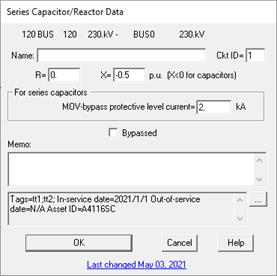 on the Device Palette. The cursor
will become a cross with a capacitor symbol attached to it.
on the Device Palette. The cursor
will become a cross with a capacitor symbol attached to it.The New | Series Capacitor/Reactor command in the Main Window lets you add a new series capacitor or series reactor between two buses. A series capacitor can be protected by an MOV. Both series capacitors and reactors can be bypassed.
TO ADD A NEW SERIES CAPACITOR/REACTOR FROM THE DEVICE PALETTE:
1a. Select New Series Capacitor/Reactor on the Device Palette
Click on the Series capacitor/reactor button  on the Device Palette. The cursor
will become a cross with a capacitor symbol attached to it.
on the Device Palette. The cursor
will become a cross with a capacitor symbol attached to it.
2a. Drag-and-Drop the new series capacitor
Click the left mouse button on the one-line diagram where you want to place the first end of the new series capacitor/reactor. With the mouse button held down, move the cursor toward the spot where you want to place the other end of the series capacitor/reactor. A new series capacitor symbol will appear with its far end moving with the cursor.
Note: Clicking on an existing bus will attach the first end of the new series capacitor to that bus. Clicking on end segment of an existing branch will place the new series capacitor/reactor in series with that branch.
Release the mouse button where you want the series capacitor to terminate. A dialog box will appear asking you for the series capacitor/reactor data.
Note: When you move the series capacitor’s far end over an existing bus having the same nominal kV, the bus symbol will be highlighted in red. You can release the mouse button to attach the second end of the series capacitor to that bus.
Enter nominal kV for the new series capacitor’s terminals when neither terminal is connected to an existing bus.

Note: If you place the second end too close to the first one, the program will ignore the command.
TO ADD A NEW SERIES CAPACITOR/REACTOR USING MENU COMMAND:
1b. Select the two terminal buses.
Note: Two buses can be connected by a series capacitor/reactor only if they have the same nominal kV. (The nominal kV values appear on the one-line diagram below the bus names.)
Click the left mouse button once on one of the terminal buses. Then with the <Shift> key held down, click the left button once on the other terminal bus.
Both bus symbols will turn dotted red when selected. The first bus you select will be Bus1 of the series-capacitor/reactor model, and the second will be Bus2.
2b. Select the Network | New | Series Capacitor/Reactor command.
Note: The Series Capacitor/Reactor menu item is dimmed and cannot be activated if the nominal kVs of the two terminal buses are not the same.
A dialog box will appear asking you for the series capacitor data.
3. Input the series capacitor/reactor identifiers.
The series capacitor/reactor’s terminal buses are listed at the top of the dialog box.

Name: A 16-character name for the series capacitor/reactor.
Ckt ID: A two-character circuit identifier that is commonly used to differentiate between parallel branches.
4. Input the series capacitor’s electrical parameters.
R and X: The resistance and reactance of the capacitor/reactor in per unit. Enter a negative reactance for a capacitor and a positive value for a reactor.
Bypass flag: When this flag is checked, the program will model the series capacitor or reactor with a very small reactance (the switch reactance) in place of the capacitor/reactor impedance. Please refer to the documentation for the Network tab of the File | Preferences command for details on the switch reactance.
MOV-bypass protective level current: This parameter is for series capacitors only. The protective level current is used to characterize the MOV that is in parallel with the series capacitor. The protective-level current is defined as Vpk/(1.414*X), where Vpk is the maximum capacitor voltage maintained by the MOV, and X is the reactance of the capacitor bank. The protective-level current is typically 2.0 to 2.5 times the rated current of the capacitor bank. Please refer to Section 4.3 LINES & SERIES CAPACITORS/REACTORS for more information on series-capacitor modeling.
Note: MOV-protected series capacitors are nonlinear device. To simulate these devices properly, the short circuit logic has to iterate the solution until convergence. The iteration logic is ‘off’ by default. You can turn it ‘on’ in the Fault Simulation tab of the File | Preferences dialog box.
5. Enter a memo.
The memo is for any notes you wish to keep for this series capacitor or reactor. It can have up to 512 characters.
Click on the … button near the upper right corner of the text area below the Memo field to open the Supplemental Object Properties dialog box with a data grid to enter data for the following data fields:
6. In/Out of service date: Click on the … button and enter the desired dates. See the Details and Techniques section “In/Out of service and tags” for more information.
7. Tags: Enter list of tag strings separated by semicolon. The tags are for organizing objects that are related for some purpose. Please see documentation for Network | Apply Tag for more information.
8. User-defined fields: These are custom data fields that are defined by the user. Please see documentation for File | Preferences for information about how to specify the template for these data fields.
9. Press OK.
A new series capacitor/reactor symbol will be shown connecting the two terminal buses.
Main Window
NETWORK MENU